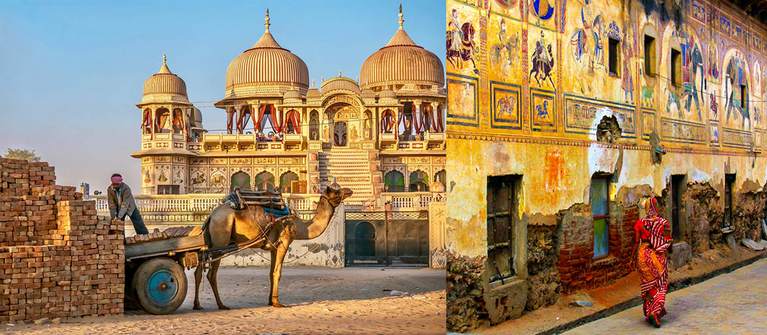
Shekhawati
Shekhawati region is famous for providing the highest number of persons to the Indian Army. The people of Shekhawati are considered brave, sacrificing and hard working people. However, Shekhawati is famous on the tourist circuit for another reason altogether: its mansions with brilliant frescoes on walls and ceilings. There are so many havelis here that the entire region is referred to as an Open Art Gallery. Horse safaris are another major attraction of this region. Fine Marwar horses are used for the safaris and for riding.
Shekhawati is named after the Rajput Kachhwaha chieftain Rao Shekha Ji. The descendants are called Shekhawat. The story of Shekha's birth provides the clue to the origin of this name. Mokal Ji and his wife had no son (heir) for several years. They heard about the miraculous powers of Sheikh Burhan, a Muslim saint and visited him for his blessings. A son was eventually born to the couple. To honour the mendicant, the couple named their son Shekha. Shekhawati means Garden of Shekha or Land of Shekhawat Rulers.
There is also another explanation for the name Shekhawati. ‘Sheekh’ which means ‘Sand deposited on the coastal area of sea’ is a Persian word that is attributed with the origin of the name Shekhawati. Millions of years ago this land actually was a sea that eventually dried and in its place came the desert.
Jhunjhunu and Sikar are the main towns here. The climate is harsh, with temperature ranging from sub-zero in winter to more than 50 °C in summer. Rainfall is scanty. Best time to visit is from September to March. The nearest airport is Jaipur. Shekhawati is also connected by train with Jaipur and by buses with major cities of the region. Heritage on Wheels, a luxury train, includes Shekhawati in its itinerary.
Popular Rajasthan Tour Packages
- Forts and Palaces of Rajasthan
- 18 Nights - 19 Days
- Palaces of Rajasthan with Classical India
- 14 Nights - 15 Days
- Colourful Heritage Tour
- 14 Nights - 15 Days
- Forts and Palaces with Wildlife
- 11 Nights - 12 Days








